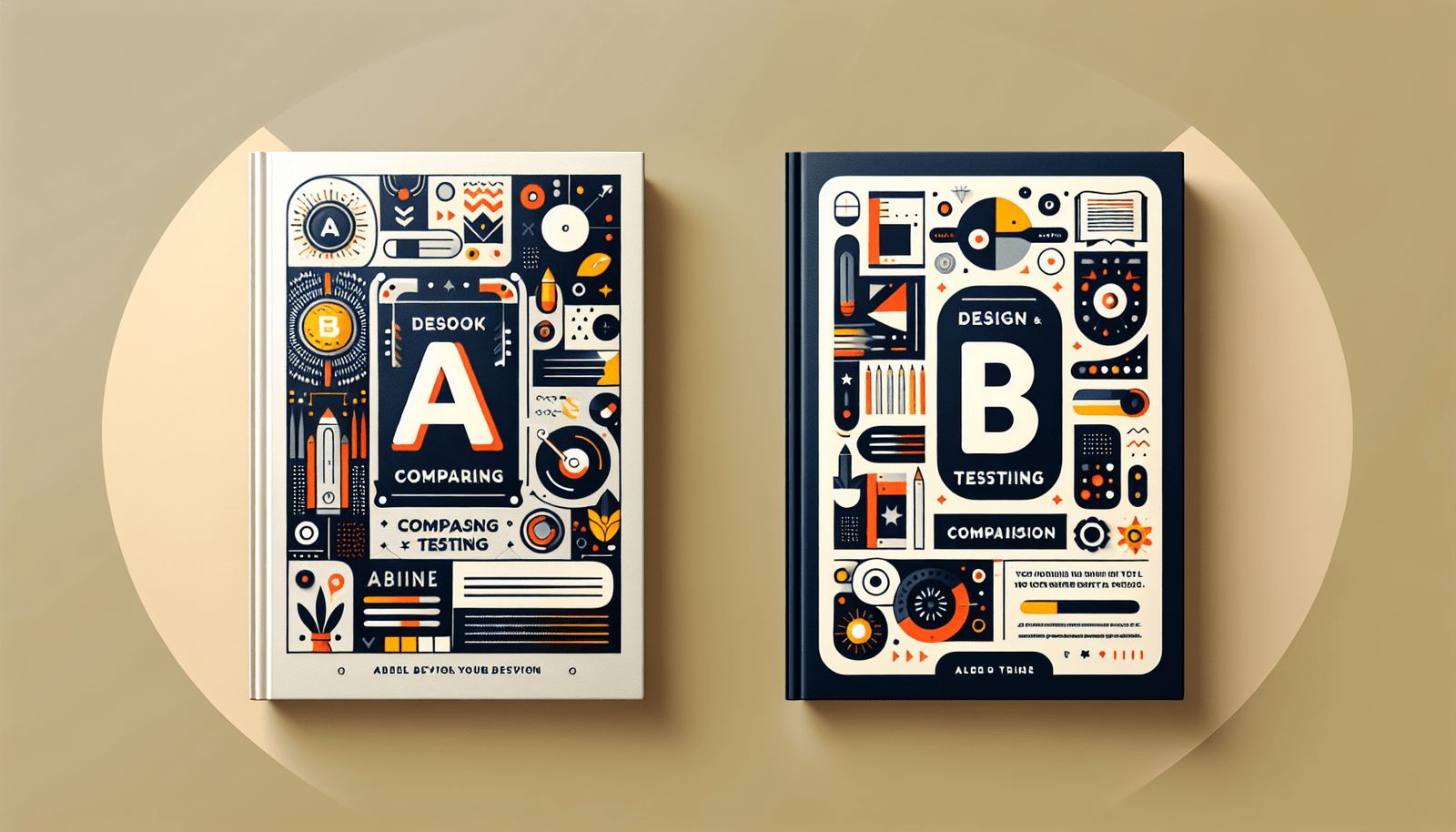Imagine the thrill of your e-book cover catching the eyes of countless eager readers, standing out amidst a sea of competition. In “How Can A/B Testing Revolutionize Your E-Book Cover Design for Maximum Reader Engagement?” you’ll discover how A/B testing can be your secret weapon in crafting the perfect cover. By comparing different designs and gathering real-time feedback, you can fine-tune every element to ensure it resonates with your target audience. Get ready to transform your e-book’s first impression into an irresistible invitation for readers to dive in!
Have you ever wondered if the design of your e-book cover could be the difference between a potential reader clicking to learn more or scrolling past without a second glance? You’re not alone. Many authors and publishers wrestle with this very question. And believe it or not, the answer can significantly impact your reader engagement and ultimately, your book’s success.
In this article, we’ll explore how A/B testing can revolutionize your e-book cover design for maximum reader engagement. So, grab a cup of coffee, and let’s dive into the world of A/B testing and e-book cover design!
What Is A/B Testing?
A/B testing, sometimes referred to as split testing, is a method of comparing two versions of a webpage, app feature, email, or in this case, an e-book cover, to determine which one performs better. Essentially, you create two variants of the same element and then distribute them to different segments of your audience to see which version garners more engagement.
Why Use A/B Testing for E-Book Covers?
Your e-book cover is often the first thing a potential reader notices. An appealing cover can capture interest, evoke curiosity, and ultimately drive a purchase. Here’s why using A/B testing specifically for your e-book covers can be a game-changer:
- Objective Decision Making: Rather than guessing which cover might be more appealing, A/B testing provides data-driven insights.
- Increased Reader Engagement: The right cover can significantly increase clicks, downloads, and sales.
- Improved Branding: Consistently engaging covers strengthen your brand image and reader expectations.
How to Get Started with A/B Testing
Starting with A/B testing may seem daunting, especially if you’re new to it. But fear not, here are some simple steps to get you started on the right foot.
Step 1: Identify Your Goal
Before diving into A/B testing, identify what you hope to achieve. Are you looking to increase clicks, downloads, or conversions? Having a clear goal in mind will guide your testing process and make your results more actionable.
Step 2: Choose What to Test
Understanding what elements to test is crucial. Start by identifying key components of your e-book cover that might impact engagement. These can include:
- Title Font and Size: Does one font capture more attention than another?
- Color Scheme: Do brighter colors perform better than muted tones?
- Imagery: Are abstract designs more engaging than photographic ones?
- Tagline Positioning: Does the placement of your subtitle or tagline affect readability and interest?
Step 3: Create Variations
Once you’ve identified what to test, create two different versions of your e-book cover. For example, if you’re testing color schemes, one cover could have a blue theme while the other could be red. Make sure that each version is only different in the element you are testing for accurate results.
Step 4: Distribute Your Test
With your two versions ready, you need to distribute them to your target audience. You can use various platforms for this, such as your own website, social media channels, or through paid advertising like Facebook Ads. The key is to have a large enough sample size to get reliable results.
Step 5: Measure the Results
After your test has run for a sufficient time period, it’s time to analyze the results. Measure the key metrics that align with your initial goal, whether they be clicks, downloads, or sales. Use these insights to finalize your cover design.
Case Studies: Real-World Examples of Successful A/B Testing
Let’s take a look at some real-world examples where A/B testing significantly impacted e-book cover design and subsequent reader engagement.
Case Study 1: The Romance Novel
Author Jane Doe was torn between two cover designs for her romance novel. One featured a couple embracing, while the other was a minimalist design with just the book title and a heart symbol. By running an A/B test:
- Cover A (Couple Embracing): 2000 impressions, 400 clicks
- Cover B (Minimalist): 2000 impressions, 150 clicks
Result: Cover A had a higher click-through rate, which led Jane to choose the more engaging cover, subsequently increasing her book downloads by 25%.
Case Study 2: The Business Book
A publishing company needed to decide between two covers for a new business e-book. Cover A had a professional stock photo with traditional typography, while Cover B had a more modern, infographic-style design. After A/B testing:
- Cover A (Professional Photo): 1500 impressions, 300 downloads
- Cover B (Infographic Style): 1500 impressions, 450 downloads
Result: Cover B outperformed Cover A, leading to a 50% increase in downloads and reinforcing the author’s brand for modern, practical business advice.
Critical Metrics to Track in A/B Testing
To ensure that your A/B test is effective, you’ll need to track specific metrics. Here are some key performance indicators (KPIs) you should focus on:
Click-Through Rate (CTR)
The Click-Through Rate measures how many people saw your cover and decided to click on it to learn more. A higher CTR indicates that your cover is engaging and effective.
Conversion Rate
The Conversion Rate tells you how many people followed through with a desired action, such as downloading your e-book or making a purchase after clicking on the cover.
Engagement Time
This metric measures how much time a user spends engaged with your book’s webpage after clicking on the cover. Longer engagement times usually indicate higher interest and satisfaction.
Bounce Rate
The Bounce Rate is the percentage of visitors who navigate away from the page after viewing your e-book cover. A lower bounce rate suggests that your cover is effectively drawing readers in.
Tools and Platforms for A/B Testing
There are several tools and platforms available that can simplify your A/B testing process. Here’s a short list of some popular ones:
| Platform | Features | Price Range |
|---|---|---|
| Optimizely | A/B testing, multivariate testing, personalization | $ |
| Google Optimize | A/B testing, integration with Google Analytics | Free and Paid Tiers |
| VWO | A/B testing, heatmaps, insights, and surveys | $$ |
| Unbounce | Page and cover variants, A/B testing, landing page builder | $$ |
| Facebook Ads | Ad split testing, audience targeting, real-time results | Pay-as-you-go |
Common Pitfalls and How to Avoid Them
Even with the best intentions, A/B testing can go wrong. Here are some common pitfalls to avoid:
Small Sample Sizes
Testing with a small sample size can lead to inconclusive or misleading results. Make sure you have enough participants to derive meaningful insights.
Testing Too Many Variables
When you test multiple elements simultaneously, it’s hard to identify which change led to the result. Focus on one variable at a time for more accurate insights.
Short Testing Periods
Ending your test too soon can lead to inaccurate conclusions. Allow the test to run for a sufficient duration to gather ample data.
Ignoring the Data
Sometimes the results may not be what you expected. Resist the urge to go with your gut feeling and stick with what the data tells you.
Making Sense of the Data
Once you’ve conducted your A/B test, you’ll be flooded with data. Here’s how to make sense of it:
Analyzing Results
Use statistical analysis to determine if the difference in performance between your variants is significant. Solutions like Chi-square tests or t-tests can help.
Iterative Improvement
A/B testing isn’t a one-time activity. Use the insights gained to conduct further tests and make continuous improvements to your e-book cover design.
Implementing Changes
Once you’ve identified the winning design, implement these changes consistently across all platforms where your e-book is displayed.
The Future of E-Book Cover A/B Testing
As technology evolves, A/B testing is becoming more sophisticated. Machine learning and AI are opening new doors for predictive analysis and even automated cover generation. Keeping abreast of these advancements will further empower you to make data-driven decisions for your e-book cover designs.
Conclusion
A/B testing is a powerful tool that can revolutionize your e-book cover design, driving maximum reader engagement and, ultimately, more downloads and sales. By understanding what appeals to your audience and making data-driven decisions, you can ensure that your e-book cover stands out in a crowded market.
So, are you ready to put A/B testing to the test? Start small, analyze your results, and iteratively improve your design to captivate and engage your readers like never before. Your next best-seller might just be a perfect cover away!
Feel free to ask any questions or share your experiences with A/B testing in the comments. We’re all here to learn and grow together. Happy testing!
Hope you found this article helpful and insightful! If you liked it, don’t forget to share it with fellow authors and publishers who might benefit from it.



